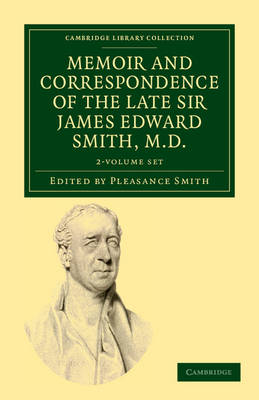Cambridge Library Collection - Botany and Horticulture
2 primary works • 3 total works
Volume 1
Memoir and Correspondence of the Late Sir James Edward Smith, M.D.: Volume 1
by James Edward Smith
Published 24 November 2011
Originally published in 1832, this two-volume account of the life of Sir James Edward Smith (1759–1828) was posthumously compiled by his wife, Pleasance (1773–1877). Smith trained originally as a doctor, but his independent wealth enabled him to pursue botany. Hugely influenced by the work of Linnaeus, he benefited greatly from the purchase of the latter's library and herbarium in 1783, upon the advice of his friend, Sir Joseph Banks. He was highly regarded throughout Europe as a botanist, and in 1788 founded the Linnean Society. He published various botanical works, of which the most important was The English Flora (1824–8), and assisted in the publication of many more. His wife recounts his character as well as his achievements, using both narrative and 'various familiar and domestic letters' to do so. Volume 1 includes letters from Banks and Samuel Goodenough, bishop of Carlisle and Smith's close botanical friend.
Volume 2
Memoir and Correspondence of the Late Sir James Edward Smith, M.D.: Volume 2
by James Edward Smith
Published 24 November 2011
Originally published in 1832, this two-volume account of the life of Sir James Edward Smith (1759–1828) was posthumously compiled by his wife, Pleasance (1773–1877). Smith trained originally as a doctor, but his independent wealth enabled him to pursue botany. Hugely influenced by the work of Linnaeus, he benefited greatly from the purchase of the latter's library and herbarium in 1783, upon the advice of his friend, Sir Joseph Banks. He was highly regarded throughout Europe as a botanist, and in 1788 founded the Linnean Society. He published various botanical works, of which the most important was The English Flora (1824–8), and assisted in the publication of many more. His wife recounts his 'religious, social and scientific character' as well as his achievements, and Volume 2 includes correspondence from Alexander von Humboldt, and concludes with an appendix in which short papers by Smith present a variety of topics.
Memoir and Correspondence of the Late Sir James Edward Smith, M.D. 2 Volume Set
by James Edward Smith
Published 24 November 2011
Originally published in 1832, this two-volume life of Sir James Edward Smith (1759-1828) was posthumously compiled by his wife, Pleasance (1773-1877). Smith trained originally as a doctor, but his independent wealth enabled him to pursue botany. Hugely influenced by the work of Linnaeus, he benefited greatly from the purchase of the latter's library and herbarium in 1783, upon the advice of his friend, Sir Joseph Banks. He was highly regarded throughout Europe as a botanist, and in 1788 founded the Linnean Society. He published various botanical works, of which the most important was The English Flora (1824-8), and assisted in the publication of many more. His wife recounts his character as well as his achievements, using both narrative and 'various familiar and domestic letters' to do so.

